– 20 October, 2017
While on the one hand, it may be valuable to call out a few convenient fictions, on the other, there are films worth celebrating and re/watching upon their selected return to theatrical release. 'The Square','Manifesto', 'Final Portrait', 'Beuys: Art as a Weapon', and 'Leaning in to the Wind: Andy Goldsworthy' reflect an array of possibilities and results.
Representations of Artists in the NZIFF
The Square
Manifesto
Final Portrait
Beuys: Art as a Weapon
Leaning in to the Wind: Andy Goldsworthy
Emerging from the Civic Theatre’s gilded royal blue cavern after viewing The Square, blinking in to the fading light of a wet winter evening, it was a scene, I thought, not unlike that painted in this year’s New Zealand International Film Festival poster. Shaken by the film, for a period I wandered aimlessly in the soft rain of central Auckland looking for a private place to cry.
Thinking the Central Public Library might provide a quiet corner, I entered to find much of its internal skeleton boarded up while under construction. A homeless man carried large bags full of clothes awkwardly down an escalator and out in to the night. He felt plucked directly from the film, its skewed reality seemingly projected everywhere. Soon enamoured by others in hushed corridor conversation, charging their phones and intently engaged with the Library’s collections, I regained my composure and renewed faith in public space. I ventured home, the film haunting me since.
While we’re working metaphors of public space, reflecting on representations of artists in this year’s film festival is certainly no walk in the park. There was a wildly diverse selection of films portraying the lives of artists, and the terrain is slippery to begin. Many of these films are included in the festival’s ‘Portrait of an Artist’, and a selection will return in some form. Alongside Pantograph Punch’s incisive capsules of key films, other pieces discussing artists within their coverage include Lana Lopesi on China’s Van Goghs, Brannavan Gnanalingam on Faces Places, and Doug Dillaman draws interesting parallels between the lives of artists in Let the Sunshine In and The Love Witch.
Zita Joyce’s recent essay on the portrayal of fictional artists in narrative television provides a fitting critical backdrop for my own meandering thoughts through this uneven terrain. Joyce also demonstrates how entrenched stereotypes of artists are perpetuated in mainstream media, and charts their lasting impact on public opinion. She also draws on Roger Horrocks’ analysis of the New Zealand news media’s longstanding record of irresponsible coverage of the visual arts. These researchers demonstrate that the embellished or fabricated generation of controversy has ultimately been at the expense of artists, and cost wider support and funding for the arts. Addressing media commentators’ portrayal of New Zealand’s participation in the 2005 Venice Biennale, for example, Joyce notes the “[r]epresentation of the art and artist were therefore at the service of a populist position within a grander media narrative.”
We might further trace these media-fuelled ‘controversies’ to Michael Parekowhai’s recent public art work The Lighthouse. Lana Lopesi analyses the media coverage and critical reception in the lead up to the official opening, beginning by foregrounding the social processes by which we devalue art, and by extension, those who choose to produce it. She cites one media stereotype of the artist as “an unstable and morally dubious figure…a struggling or con artist, who bends the rules to sustain an alternative lifestyle most of us can’t have.” Beyond the buzz kill of mainstream media, artists also inhabit numerous roles which provide for more open conversations: artists as citizens, public intellectuals, educators, tricksters, activists, community workers, healers…
Those roles, however, may prove less cinematic. It’s hard to see them doing as well at the box office. Unsurprisingly, stereotypical representations of artists stubbornly persisted in this year’s festival. While on the one hand, it may be valuable to call out a few convenient fictions, on the other, there are films worth celebrating and re/watching upon their selected return to theatrical release. The Square, Manifesto, Final Portrait, Beuys: Art as a Weapon, and Leaning in to the Wind: Andy Goldsworthy reflect an array of possibilities and results. They span artists as filmmakers, artists on film, artists as collaborators, and actors as artists.
The Square
While writer-director-editor Ruben Östlund’s The Square is exceptional, it’s also torture, albeit perhaps a pleasurable kind of pain. The pervasive feeling of tension and foreboding is intense, and thankfully punctuated with episodes of dark humour. In the ‘art joke’ camp, this includes a man with Tourette’s shouting obscenities during an artist’s talk, a critique of the worst contemporary ‘art speak’, and a ‘cleaner’s dilemma’ gag.
The film is centred around the figure of Christian, a handsome, respected contemporary art curator (played by Claes Bang) at X-Royal Museum in Stockholm. The prestigious yet dysfunctional museum is framed as a microcosm of both the art world and the wider society it precariously inhabits.
This satirical, edgy comedy takes aim at the contemporary art world’s disconnection from, and hypocrisy towards, the communities it is ostensibly charged (or claims) to serve and represent. Östlund’s vignettes cumulatively reveal the ongoing struggles of the contemporary art world: caught between the potential drive to stage radical and inclusive social interventions, and the exclusive funding structures and elitist practices which underpin the financial operations and culture of this world. It is the disconnect—between individuals and different social groups—which is so beautifully and disconcertingly painted here. Though contemporary art serves as the central motif, the film traces the West’s intricately woven yet increasingly frayed social fabric.
Though The Square appears to have little sympathy for the lived experience of artists themselves, at times equating them with the hypocritical culture Östlund perceives, this is countered with glimpses of art’s transformative potential. Artists adopt a number of archetypal forms here, from contemporary utopian, to safe institutionalised player, to dangerous radical. There’s even an orangutan who paints.
The central artist figure is the cited yet conspicuously absent Lola Arias, creator of the eponymous art work on which the film is based (1). Arias instructs X-Royal to set a narrow white strip of LED light in a four by four metre square section of cobblestoned pavement in the ‘square’ outside the museum’s entrance (2). Arias’ subtle intervention is accompanied by a gold plaque. Its engraved text asserts that the space within the square is a sanctuary of trust and caring, a space in which everyone has equal rights and obligations. Arias’ utopian delineation of public space—a kind of ‘sacred geometry’—offers the opportunity for reflection on our interpersonal relationships and their role in the wider functioning of society.
Christian references Nicholas Bourriaud’s influential book Relational Aesthetics as a theoretical key to understanding the square art work, and by implication, aspects of the film itself. The field of relational aesthetics’ shift in focus from art objects to experiences can be seen to reframe the film’s characters encountering the art works, and each other, as constituting art. Square forms recur, notably in a team gymnastics sequence, a Josef Albers painting and the white cube of the gallery, extending to the film frame and viewing experience.
Early in the film, homeless people are depicted bordering a public plaza while a fundraiser for a human rights NGO asks commuters, “will you save a human life?” A sea of people uniformly pass her by, their silence a resounding “no”. Given the film’s layered symbolism of doubles, mirrors and foils, when Christian, fellow gallery staff and art world insiders later dance to the disposable electro version of How Deep is Your Love? at an exclusive after party it is clear Östlund is implying this very question.
In stark contrast to Arias and her earnest and inclusive gesture, is the figure of Julian: a successful, institutionalised insider artist dressed in baby blue ‘art pyjamas’. Julian (Dominic West) is mounting a seemingly impenetrable show called Mirrors & Piles of Gravel which consists of—you guessed it—mirrors and piles of gravel. Think recycled Robert Smithson, yet learning nothing from what underpinned his artistic project. Driving the (emperor’s new clothes) joke home, the exhibition also features a flat panel television which is switched off or at least plays only a black screen, and a custom made white neon sign proclaiming: YOU HAVE NOTHING. Julian appears unable to transfigure these materials in to an exhibition which resonates with anything beyond the sum of its parts. In this sense, he and his work are framed as examples of alienating, elitist contemporary art. The ‘con artist’ referred to earlier. Two visitors tentatively poke their heads around a corner, past a bored looking gallery assistant and in to the entrance of Julian’s show, only to make a hasty retreat. Cue audience laughter.
At the other end of the spectrum there is Oleg, a confrontational performance artist who acts convincingly as an ape (played by the actor, stunt double and movement coach Terry Notary). Notary delivers a sensational performance as a wild primate at a wealthy museum patrons’ dinner. The dinner audience’s collective inability to intervene in Oleg’s violation of its members is deeply unsettling to watch. Sans spoilers, there are notes of an infamous early Marina Abramovic performance with a similar outcome. Oleg is wild: he is an outsider, a radical destroyer-creator who punches through the paper-thin veneer of seemingly tolerant Swedish society. The result is spectacular chaos.
Though not an artist, Christian, our flawed yet endearing curator protagonist, is also a creative. Christian is a conceptual collaborator who develops propositional exhibitions based on Arias’ central gesture. These ask compelling questions of visitors’ trust in others, and reflect on his recent personal experiences in the way an artist might. However, Christian’s portrait also fulfils certain stereotypes of the contemporary art curator. He is an insider-player who struggles to understand and empathise with the lives of others, to perceive his own privilege and see life beyond the subtle operations of his insular social sphere. He is portrayed as a well-meaning but often misguided cultural diplomat wrestling with a complex web of stakeholders whose needs are innumerable and often incompatible. This more nuanced aspect of his portrayal suggests curators’ survival necessitates prioritising the needs of certain stakeholders above others. Yet they don’t have it nearly as easy as outsiders might like to believe.
The narrative arc of Christian’s unravelling personal and professional life foregrounds the need for moral courage in these complex, contradictory and challenging times. The film suggests these are times in which—like it or not—we are all in this together. Here is the bonkers trailer. All killer, no filler.
Manifesto
Manifesto by artist and filmmaker Julian Rosefeldt, sees actor Kate Blanchett adopt a multitude of different characters whose monologues champion excerpts from selected influential art manifestos. Despite perhaps being considered a largely twentieth century phenomenon, manifestos are in fact alive and well, their provocations an opportunity to reflect on artists’ explicitly and/or poetically stated values and beliefs, and by implication, our own.
Blanchett may be playing artists here, but if so it’s those doing their day jobs. As described in the credits, the characters include: a stock broker, a homeless man, a punk musician, scientist, CEO, conservative housewife, choreographer, puppeteer and primary school teacher. Some of these characters may see their work as an art form (as may some audiences), and perhaps rightly so. Yet the contrivance of orchestrating these characters to read such loaded and radical texts will polarise audience responses, particularly because the manifestos are so divorced from their original contexts. For this reviewer, the film is uneven: some scenes work and some don’t.
A Dada manifesto read aloud at a funeral resonates, a poignant echo of Dada’s radicalised politics in reaction to the lived horrors of World War One, a global funeral on an epic scale. At the other end of the spectrum, Blanchett’s conservative housewife reading a Pop Art manifesto as ‘grace’ before a family roast dinner is priceless.
Blanchett as Jude Quinn (Bob Dylan) was mesmerising in moments of I’m Not There, a “crazy idea” that somehow seemed to work. The disjuncture between Rosefeldt and Blanchett’s constructed characters, and the values they espouse, is crucial to evaluations of the film. However appealing Manifesto might appear in theory (this may depend on how much of a Blanchett fan you are), for this reviewer, unfortunately the performances were patchy, with some overcooked and others unconvincing. In some instances, it is the writing and direction responsible. This is an ambitious and innovative cinematic experiment, however.
The names of the associated art movements and their key proponents appear in the dynamic opening credits set to glitchy minimal techno, yet the manifestos remain entirely decontexualised until the end credits. To further muddy the waters, each of the monologues often contain excerpts from two different manifestos. It didn’t feel constructive or critical to combine manifestos which emerged from such disparate personal, cultural and historical contexts in to a single monologue. For me, this truncated the unique clarity and power of each text, a central tenet of any manifesto. The film was richer on a second viewing however, and continues to confuse as to whether I admire its totality or not. I can’t quite shake it. This is recommendation enough.
Final Portrait
In all likelihood, Final Portrait will be widely praised as a charming adaptation of James Lord‘s book A Giacometti Portrait, which details the painting of Lord’s portrait by Swiss Italian artist Alberto Giacometti. True, the film is lively, entertaining and well-paced. The problem is that its characterisation of the artist is grotesque. Giacometti’s portrayal is so stereotypical that at times it resembles little more than a caricature. Not having read Lord’s book, one is forced to level this criticism both at the film adaptation and actor Geoffrey Rush’s representation of the artist. Surely a more nuanced picture was possible, as aspects of Final Portrait feel dangerously populist.
On the other hand—if Lord is to be believed—it would appear Giacometti fulfilled many artistic stereotypes, making him an ideal subject for a film which reinscribes the artist-as-tortured-genius (3). Here Giacometti constantly wrestles with crippling self-doubt, subject to rapid mood swings, eccentricities and destructive behaviour. He is intense, prone to self-indulgence (in one scene he casually downs a glass of red wine followed by two espressos in quick succession), one who doesn’t care for money (perhaps because he is swimming in it), and is openly engaged in adultery with a prostitute, an obsession and muse. At one point he shares a dark sexual fantasy with Lord which is left inexplicably hanging. I’m unsure what was intended by this irresolution, yet as with many accounts of important (almost exclusively male) modernists, the audience is forced to confront tensions between the aesthetic contribution of their work and the human failings of the figures themselves.
Rush’s performances internalise a convincing conception of the artist in his posture and body movement. In one elongated take shuffling around in his studio, he lights a cigarette while sharing his musings on art, stubs it, nonchalantly destroys part of a sculpture he is frustrated with, and lights another. In contrast, unfortunately some other scenes are overblown and even his accent lapses in places.
Set in Paris 1964, the film leans heavily on the mystique of the locale, a city as mythologised as the artists to which it is aligned. An extra drags a giant basket of baguettes down the street. Violins sound when the artist paints. I’m surprised there wasn’t more accordion music.
As Giacometti struggles to resolve Lord’s portrait, he asserts “I will never paint you as I see you—it’s impossible”. Giacometti’s provisional, sketch-like style is perpetually teetering on the brink of overpainting and subsequent abandonment. There is a moment where the artist declares his portrait has “gone too far, at the same time not far enough”. This is, perhaps, an unforeseen metaphor for the film itself. Let’s hope it’s not Giacometti’s final portrait. That said, I must admit to enjoying the experience despite the film’s potential ideological shortcomings and my best intentions not to.
Beuys: Art As a Weapon
Beuys: Art As a Weapon presents the life of German artist Joseph Beuys in fresh and imaginative ways using moving image, photographic and sound archives. This slick German production (with English subtitles) successfully activates an expansive audio-visual archive to create a compelling, contemporary study of the influential artist.
The animation of contact sheet and clock motifs maintain visual movement, alongside subtle sound effects which provide aural stimulus. These contribute to the singular feel of the film without distracting from the content. The visuals are accompanied by a percussive experimental soundtrack whose prominence draws attention to the film’s audio-visual construction. It is a documentary for our time, based on what feels like an increasingly distant one.
The film opens with a kind of screen test filmed prior to an interview. The camera is rolling as Beuys enters the room. He directly addresses the audience through the camera lens: “The anonymous viewer is back there, yeah?” This sense of ‘being there’ underpins the film, giving viewers a more immediate sense of Beuys’ inner life and the specific cultural and political contexts in which he operated. Another highlight is extended footage of I Like America and America Likes Me (1974), perhaps Beuys’ most iconic performance work.
We also witness the artist strain to communicate and connect with audiences, to realise his vision for art, culture and politics. The film eschews a heroicized portrayal, instead detailing his intentions and potential successes and failures, leaving these to audiences to reconcile. Beuys’ earnest and committed attempt to expand art and transform society shine through.
As usual, the question of Beuys’ slippery ‘origin story’ is left unanswered. As a Luftwaffe pilot in World War Two, Beuys claims his plane crashed over Crimea and was subsequently rescued by local nomadic Tartars who covered him in animal fat and felt to warm his broken body from the snow, effectively saving his life. Hence the recurrence of these materials in his work. The fidelity of Beuys’ story—true, embellished or fabricated—is particularly important because it became such a myth. The film’s response to this question recycles the fence-sitting of previous accounts, where it would have been refreshing for it to stake a claim either way. Perhaps the question is unanswerable. Lucky for Beuys.
Leaning in to the Wind: Andy Goldsworthy
Director Thomas Riedelsheimer returns to collaborate with British artist Andy Goldsworthy for Leaning in to the Wind 15 years after the critical success of Rivers and Tides. The film reads as a close sequel utilising a similar methodology.
Leaning in to the Wind suggests a dynamic equilibrium between artist and nature, a kind of constant co-creation. This dynamic equilibrium is echoed in the balanced relationship between artist and filmmaker: the film’s form and treatment is well aligned with the artist’s idiosyncratic process, clearly benefitting from a close collaborative relationship. The result provides direct access to the development and realisation of Goldsworthy’s ephemeral objects, interventions and performances, otherwise absent from the still photographs through which audiences primarily experience his work.
The film traces Goldsworthy working in a range of natural environments in Gabon, Southern France, Spain, Brazil and the US. He also revisits old works in England and Scotland where nature continues to shape them decades later.
This portrait feels accurate and with a lightness of touch faithful to both Goldsworthy’s personality and his expanded conceptions of nature and time. Here we have an honest portrayal of a functional, grounded professional, a father and a man deeply invested in celebrating and protecting the natural environment. Goldsworthy’s open, humble presence and the disarming ease of the film is a respite from the usual oversimplified, mythologising portrayals of artists, whether in fiction or deferential documentary.
Goldsworthy’s increasing participation in these films suggests a further extension of his work in to moving image; and while Riedelsheimer maintains a largely observational documentary form, the soundtrack and stunning cinematography comfortably lapse in to ‘art film’ terrain. A unique and rewarding cinema experience from the outside in.
Utopian, player, radical, other: the lives of artists don’t square easily with the mythic storytelling structure dominant in mainstream film production. Artists are at times conversely mythic and mythologising in their actions, ultimately leaving us to think for ourselves. Perhaps they succeed most when they fail to meet our expectations and give us something new instead.
Emil McAvoy
(1) At the time of writing, the extent of Arias’ involvement in the film, if any, is unknown.
(2) Collector-commentators Jim and Mary Barr draw parallels with the formal resolution of Void (2006), an installation by Bill Culbert and Ralph Hotere at the Museum of New Zealand Te Papa Tongarewa (see PS, Facebook, 1 June 2017).
(3) Lord also wrote a biography on Giacometti, giving him some clout on the matter.

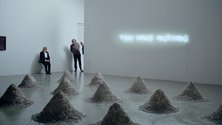
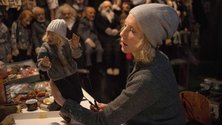

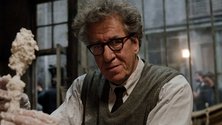
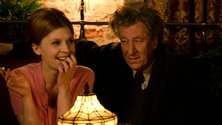
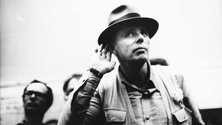
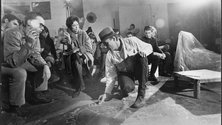
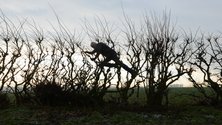
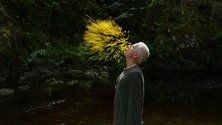
 Advertising in this column
Advertising in this column Two Rooms presents a program of residencies and projects
Two Rooms presents a program of residencies and projects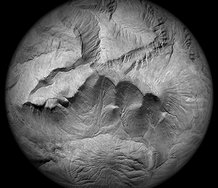
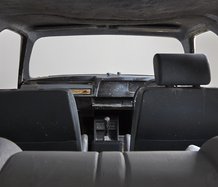
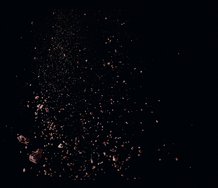
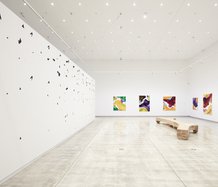
This Discussion has 0 comments.
Comment
Participate
Register to Participate.
Sign in
Sign in to an existing account.